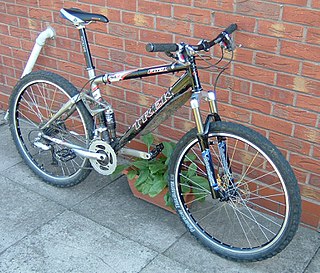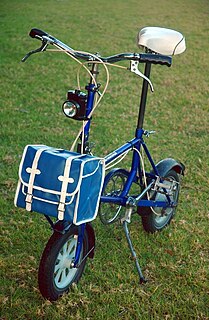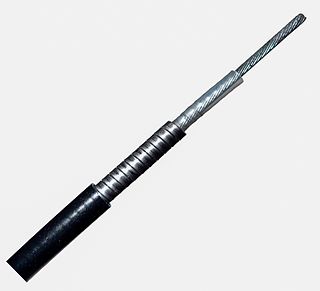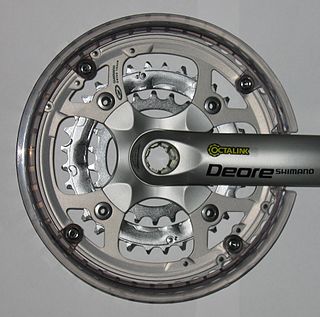
A mountain bike or mountain bicycle is a bicycle designed for off-road cycling. Mountain bikes share similarities with other bicycles, but incorporate features designed to enhance durability and performance in rough terrain. These typically include a front or full suspension, large knobby tires, more durable wheels, more powerful brakes, straight handlebars, and lower gear ratios for climbing steep grades.

A hub gear, internal-gear hub, or just gear hub is a gear ratio changing system commonly used on bicycles that is implemented with planetary or epicyclic gears. The gears and lubricants are sealed within the shell of the hub gear, in contrast with derailleur gears where the gears and mechanism are exposed to the elements. Changing the gear ratio was traditionally accomplished by a shift lever connected to the hub with a Bowden cable, and twist-grip style shifters have become common.

A touring bicycle is a bicycle designed or modified to handle bicycle touring. To make the bikes sufficiently robust, comfortable and capable of carrying heavy loads, special features may include a long wheelbase, frame materials that favor flexibility over rigidity, heavy duty wheels, and multiple mounting points.

The bottom bracket on a bicycle connects the crankset (chainset) to the bicycle and allows the crankset to rotate freely. It contains a spindle that the crankset attaches to, and the bearings that allow the spindle and cranks to rotate. The chainrings and pedals attach to the cranks. The bottom bracket fits inside the bottom bracket shell, which connects the seat tube, down tube and chain stays as part of the bicycle frame.

A track bicycle or track bike is a bicycle optimized for racing at a velodrome or outdoor track. Unlike road bicycles, the track bike is a fixed-gear bicycle; thus, it has only a single gear ratio and has neither a freewheel nor brakes. Tires are narrow and inflated to high pressure to reduce rolling resistance. Tubular tires are most often used in track racing and training, though advances in clincher tire design have seen them being used somewhat more often.

A single-speed bicycle is a type of bicycle with a single gear ratio. These bicycles are without derailleur gears, hub gearing or other methods for varying the gear ratio of the bicycle.
Various bicycle tools have evolved over the years into specialized tools for working on a bicycle. Modern bicycle shops will stock a large number of tools for working on different bicycle parts. This work can be performed by a trained bicycle mechanic, or for simple tasks, by the bicycle owner.

A fork end, fork-end, or forkend is a slot in a bicycle frame or bicycle fork where the axle of a bicycle wheel is attached. A dropout is a type of fork end that allows the rear wheel to be removed without first derailing the chain.

A kickstand is a device on a bicycle or motorcycle that allows the bike to be kept upright without leaning against another object or the aid of a person. A kickstand is usually a piece of metal that flips down from the frame and makes contact with the ground. It is generally located in the middle of the bike or towards the rear. Some touring bicycles have two: one at the rear, and a second in the front.

Bicycle gearing is the aspect of a bicycle drivetrain that determines the relation between the cadence, the rate at which the rider pedals, and the rate at which the drive wheel turns.

A belt-driven bicycle is a chainless bicycle that uses a toothed synchronous belt to transmit power from the pedals to the wheel. The belts are typically made by the same manufacturing companies that produce timing belts for automobiles, machinery, and other synchronous belt-drive applications.

Bicycle suspension is the system, or systems, used to suspend the rider and bicycle in order to insulate them from the roughness of the terrain. Bicycle suspension is used primarily on mountain bikes, but is also common on hybrid bicycles.
Centurion was a brand of bicycles created in 1969 by Mitchell (Mitch) M. Weiner and Junya (Cozy) Yamakoshi, who co-founded Western States Import Co. (WSI) in Canoga Park, California to design, specify, distribute and market the bicycles. The bikes themselves were manufactured initially in Japan by companies including H. Tano Company of Kobe and later in Taiwan by companies including Merida. The Centurion brand was consolidated with WSI's mountain bike brand Diamond Back in 1990. WSI ceased operations in 2000.

The Bootie Folding Cycle, or 'Bootie', is a rare folding bicycle produced in West Yorkshire UK from 1965 to 1973.

A gearbox bicycle is a bicycle that uses a gearbox to convert torque and rotational speed from the power source, usually the rider's legs, to what is desired at the drive wheel. The gearbox is usually incorporated into the frame near the crank, and it may be used in addition to or instead of derailleur gears or a hub gear. Cited advantages include improved shifting performance, protecting the gearing from damage and exposure to dirt and moisture, as with hub gears, plus locating the additional mass between the two wheels and on the frame where it may be suspended, unlike with hub gears.
Wittson Cycles is a Northern European handmade bicycle manufacturer located in Klaipeda, Lithuania. Wittson works exclusively with titanium and sources the European Grade 9 tubes from Baltic neighbor Sweden and the VSMPO Titan Scandinavia corporation, which also supplies aerospace luminaries Boeing and Airbus. Wittson uses 3/2.5 Ti for their frame production, and 6/4 Ti, which has greater tensile strength but is much harder to weld, for dropouts and bottom bracket shells, along with smaller bits such as brake cable stops.



















